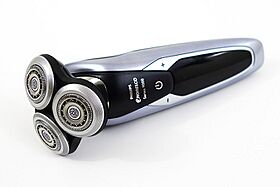Electric shaver facts for kids

Rotary-style electric shaver
|
|
|
Foil-type electric razor
|
|
| Other names | Dry razor, electric razor, shaver |
|---|---|
| Classification | Personal grooming device |
| Types | Rotary, foil, corded, battery-powered |
| Related | Electric hair clippers, safety razor |
An electric shaver is a tool that uses electricity to cut hair very close to the skin. It's also called an electric razor or dry razor. You usually don't need shaving cream, soap, or water to use it.
It works with a small motor. This motor gets power from batteries or from a wall outlet. Many new shavers use rechargeable batteries. Some very old ones even worked by hand, like pulling a cord!
There are two main types of electric shavers: foil shavers and rotary shavers. People often like one type more than the other. Many modern shavers don't have cords. They charge up with a plug or in a special cleaning and charging station.
Contents
The History of Electric Shavers
Electric shavers have been around for a long time. The very first patent for an electric razor was given to John Francis O'Rourke in New York in 1898.
Who Invented the Electric Razor?
The first working electric razor was made in 1915 by Johann Bruecker, a German engineer. Later, an American named Col. Jacob Schick patented his own electric razor in 1930. He is often called the "father of the modern electric razor."
The Remington Rand Corporation started making electric razors in 1937. Another important inventor was Prof. Alexandre Horowitz from Philips in the Netherlands. He designed one of the first rotary razors. This type of razor has spinning cutters that trim hair right at skin level.
Roland Ullmann from Braun in Germany also helped a lot. He was the first to combine rubber and metal parts on shavers. He designed over 100 electric razors for Braun and filed more than 100 patents for his ideas!
Companies keep making new and better electric shavers. They often sell different models with various features and prices. Newer improvements usually become available on less expensive models over time.
Types of Electric Shavers
Electric shavers come in different designs. The two main types are foil shavers and rotary shavers.
Foil Shavers Explained
Foil shavers have a thin, curved metal screen (called a foil) with tiny holes. Underneath the foil, blades move back and forth very quickly. The foil lifts the hair, and the blades cut it as it pokes through the holes.
Rotary Shavers Explained
Rotary shavers have spinning circular cutters. These cutters are usually found in a group of three. As you move the shaver over your skin, the spinning blades catch and cut the hairs.
Battery-Powered Electric Shavers
Electric shavers can be powered in different ways. Many modern ones use batteries.
How Battery Shavers Work
The first battery-powered electric razors came out in the late 1940s. In 1960, Remington introduced the first rechargeable battery shaver.
Today, many shavers have rechargeable batteries built inside. Older models used nickel cadmium batteries. Newer ones often use nickel metal hydride or Lithium-ion batteries. Lithium-ion batteries are great because they don't lose their ability to hold a charge over time (this is called "memory effect").
Some battery shavers plug directly into a wall outlet to charge. Others come with a special charging base. Shavers designed for wet shaving (using water) usually won't turn on while they are plugged in. This is a safety feature to prevent electric shock.
Electric Razor vs. Electric Trimmer
While they look similar, electric razors and electric trimmers have different main uses.
What's the Difference?
An electric razor is made to give you a very clean, close shave. It's designed to cut hair right down to the skin.
An electric trimmer is different. It's not for a clean shave. Trimmers often come with special combs or guards. These attachments help you trim your beard or hair to a specific length or shape. Trimmers are great for styling and grooming, not for a completely smooth finish.
Travel Shavers
Some electric shavers are made especially for travel. These are often called "travel razors" or "travel shavers."
Shavers for On-the-Go
Travel shavers often use regular AA or AAA batteries that you can replace. This is handy because you can buy new batteries easily when you're traveling, instead of needing to carry a charger.
Water-Resistance and Wet/Dry Shavers
Many new electric shavers can get wet. This makes them easier to clean.
Using Shavers with Water Safely
Most modern electric shavers are water-resistant. This means you can rinse them under water to clean them. To be safe, always unplug the shaver from its charging cord before you clean it with water.
Some shavers are called "Wet/Dry" models. This means you can use them in wet places, like in the shower or with shaving cream. These shavers are always battery-powered. They usually won't turn on if they are plugged into the charger. This is a very important safety rule to prevent electric shock, especially if you're using them in a bathtub or shower.
Lady Shavers
A lady shaver is a special electric shaver made for women. It's designed to remove body hair.
Shavers for Women's Body Hair
Lady shavers usually look similar to men's foil shavers. Sometimes, a shaving attachment is part of an epilator kit. An epilator is a device that removes hair by pulling it out from the root, but some come with a separate head that shaves instead.
Body Hair Shavers for Men
While traditional men's shavers are for facial hair, there are also electric shavers made specifically for men's body hair. These are designed to safely and easily trim or shave hair on other parts of the body.
Images for kids



